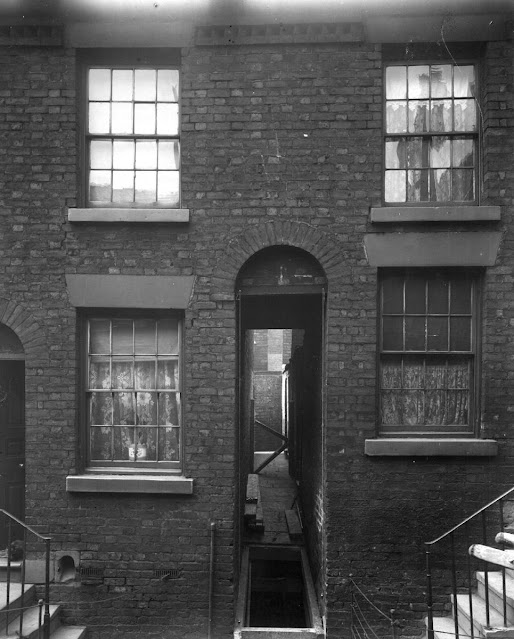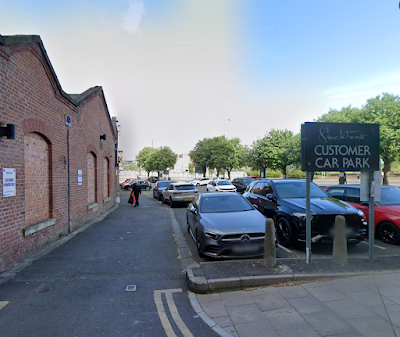I say serendipity which according to the dictionary is “the fact of finding interesting or valuable things by chance” and it was a bit out of the blue that someone asked today about Store Street just days after I had written about the place.
 |
| Living off Store Street, 1904 |
 |
| Store Street and Fairbairn’s Buildings, 1849 |
The request related to the height of buildings along the last stretch where it joins Great Ancoats Street.
And this was in some ways slim pickings.
The main building after Junction Street was the Vulcan Iron Foundry which was doing the business of bashing metal from 1849, and while the building was still there in 1894, it was disused but later repurposed as an Iron and Steel warehouse.
And most of it still serves a place where metal is worked.
Opposite in 1849 was an open space which over the centuries became a timber yard, a scrap metal business and in the early 2000s a collection of undistinguished red brick workshops, before being swept away in 2019 for a tall development.
Now, as unpromising as the first search seemed to pan out, this was one of those fascinating places which mirrored the swift development of this bit of the city.
The arrival of the Ashton Canal and its neighbour the Rochdale Canal in the 1790s followed by the railway in 1842 turned the area into a thriving industrial and residential area which in turn takes us back to the Vulcan Iron Works and directly behind the Shooter’s Brook Iron Works.
And it is this later foundry which has drawn me in, because in 1851 it was owned by a William Fairbairn who had a portfolio of properties known as Fairbairn’s Buildings.
 |
| Store Street and Fairbairn’s Buildings, 2025 |
There were five in all and commanded rents ranging from six shillings and eight pence to two shillings and 9 pence with a charge of just over a shilling for one of the cellars. Not that they got into the street directory but we know who lived in them, through the Rate Books.
That said the resident in 1851 are proving elusively difficult to find on the census record.
Leaving just the site of where they lived which is still there off Store Street and runs up the side of Stockton’s Furniture Store and a car park.
For those who want to walk the walk Fairbairn’s Buildings took up perhaps half that car park.
As for William Fairbarin he is recorded in the street directories and census records as an engineer and lived at “6 Polygon beyond Ardwick Green” in the then fashionable and well healed area, home to merchants, manufacturers and cotton spinners.
And now I am not so sure. This William Fairbarin was a notable engineer ending up as a baronet, and I think may not have engaged in muky business and property.
The trouble is the only other possible candidate also gave his occupation as an engineer but lived in Fielden Street which was off Oldham Road in that desnley packed part of the city a far cry from the Polygon.
And that is it.
Other than to say that the image Living off Store Street, in 1904 was Stand Street, now gone, and it was originally Scholes Square, a place of which I have already written about.**
And here I cheated because it was located at the other end of Store Street, but it is a striking image and deserves to be in.
Location; Store Street
Pictures. Stand Street, No's 26 and 28, formerly Scholes Square Passage off Store Street, 1906, m04571.,courtesy of Manchester Libraries, Information and Archives, Manchester City Council, http://images.manchester.gov.uk/index.php?session=pass, Store Street and Fairbairn’s Buildings, from the OS map of Manchester & Salford, 1849, courtesy of Digital Archives Association http://www.digitalarchives.co.uk/, and the same spot in 2025, courtesy of Google Maps
*A new book on the History of Greater Manchester by Tram, Piccadilly Gardens to New Islington, Andrew Simpson & Peter Topping available in September Buildings, https://chorltonhistory.blogspot.com/search/label/A%20new%20book%20on%20the%20History%20of%20Greater%20Manchester%20by%20Tram
**Scholes Square ….. fifty-one of its residents …. and a bit of Manchester’s past, https://chorltonhistory.blogspot.com/2025/07/scholes-square-fifty-one-of-its.html
No comments:
Post a Comment